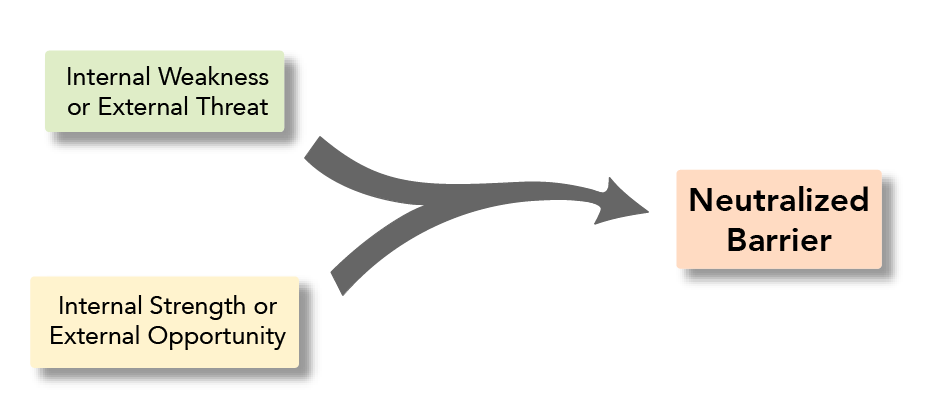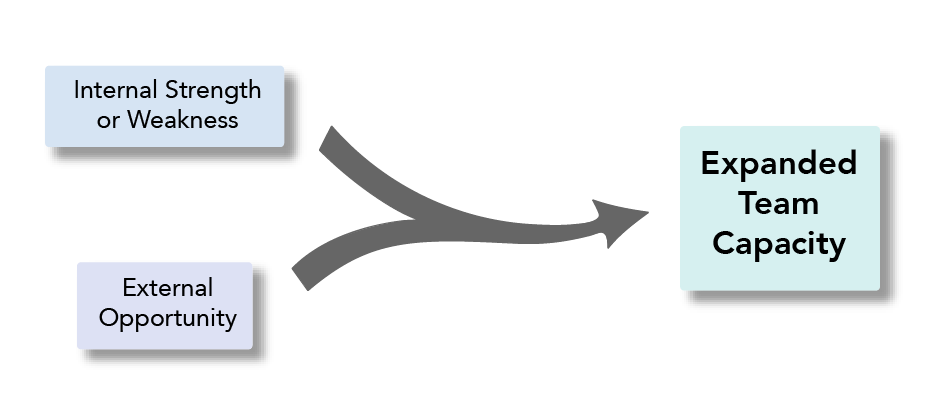Matching and Converting: Extending the Reach of the Team
Relationships among the items on each SWOT factor list are not readily apparent. Blending together, or synthesizing, the items across lists is the last part of the SWOT Analysis. Matching and Converting are strategic discussions, allowing the Team to consider items on the separate SWOT factor lists as they relate to each other, creating new possibilities for accomplishing the work ahead. The Matching and Converting discussions are intended to extend the reach of the Team by capitalizing on assets and resources (Strengths and Opportunities) and curbing the impact of barriers (Weaknesses and Threats). The resulting consolidated items are the foundation for goals and strategies in your plan.
Matching and Converting discussions are creative and meant to be lively and fun! Think beyond traditional boundaries. Contemplate ideas that sound unrealistic. Envision possibilities to forge new partnerships. Look for novel ways to gain assistance from non-traditional or atypical partners. Brainstorm combinations of SWOT factors that generate momentum and elicit support within the larger community. Thoughtfully consider any notion that expands the capacity, beyond the Team itself, to achieve elements in the plan.
The factors uncovered through the SWOT process define the landscape for strategic planning. The Strengths and Opportunities point toward pathways that may offer less resistance. The Weaknesses and Threats reveal barriers and obstacles that will require careful planning to surmount. This initial SWOT Analysis will continue to change and evolve and will assist the Team in developing goals and strategies effective for moving forward to build the capacity of the county to extend and sustain multi agency planning practices for transition youth.
Alongside root cause, the SWOT information provides the content, context and substance for what to address how to proceed to strategically achieve the systems change desired, as captured in the Team’s Vision statement. This is the essence of what it means to be strategic.
Matching
Matching involves a discussion to find advantages by matching Internal factors (Strengths and Weaknesses) with External factors (Opportunities and Threats) to create new powerful ideas. Matching Strengths internal to your Team with external Opportunities that exist within the larger community can open doors to:
- new partnerships with community, businesses or civic organizations, etc.
- avenues for combining resources with other entities and atypical community partners
- benefitting from the influence of another organization
To mention just a few possibilities. Matching internal and external factors extends the reach of your Team and is important to enlisting the wider community in maintaining and sustaining systems change. Think creatively about how to match the Strengths and connections of Team members with Opportunities that exist in the wider community.
In the same way, Weaknesses internal to your Team, and be matched with Opportunities external to your Team. Pairing an external Opportunity with an internal Weakness could potentially eliminate or mitigate areas of concern identified by the Team.
Converting
A Conversion is taking a negative Weakness or Threat and transforming it into a positive Strength or Opportunity. Converting a Weakness or Threat into a Strength or Opportunity, provides a means for addressing barriers by using the Team’s assets and resources (Internal Strengths and External Opportunities) identified in the SWOT.
The discussion to convert internal Weaknesses and external Threats to Strengths and Opportunities unfolds in the same way as that for Matching. The SWOT Worksheet Examples provide some models for how to think through various conversions.
Matching or Converting discussions can yield creative suggestions. The very ideas that initially appear ‘undoable’ or ‘way out of the box’ are often the most useful. They bear some consideration and discussion by the team, to ferret out what part of the idea could be beneficial to the Team’s plan.
Review the SWOT process on a regular basis as a Team. As the Team learns more about each other’s agencies, more Internal Strengths and Weaknesses will come to light. As the Team convenes and interacts with an Implementation Team, more will be learned about additional external Opportunities and Threats. Add these to the SWOT for consideration for Matching and Converting.
The discussion process for Matching and Converting are the same – the only difference between the two discussions is the type of Factors that are being considered.
See examples on SWOT Analysis Worksheet.
SWOT Worksheet Discussions
Matching

Converting
